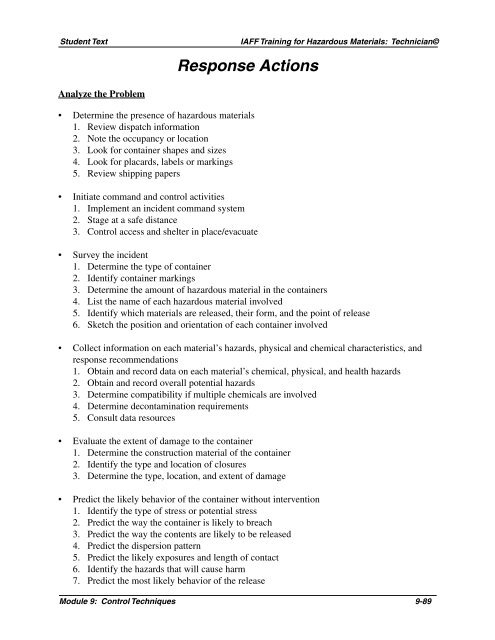Module 9: Control Techniques - International Association of Fire ...
Module 9: Control Techniques - International Association of Fire ...
Module 9: Control Techniques - International Association of Fire ...
Create successful ePaper yourself
Turn your PDF publications into a flip-book with our unique Google optimized e-Paper software.
Student Text IAFF Training for Hazardous Materials: Technician©<br />
Analyze the Problem<br />
Response Actions<br />
• Determine the presence <strong>of</strong> hazardous materials<br />
1. Review dispatch information<br />
2. Note the occupancy or location<br />
3. Look for container shapes and sizes<br />
4. Look for placards, labels or markings<br />
5. Review shipping papers<br />
• Initiate command and control activities<br />
1. Implement an incident command system<br />
2. Stage at a safe distance<br />
3. <strong>Control</strong> access and shelter in place/evacuate<br />
• Survey the incident<br />
1. Determine the type <strong>of</strong> container<br />
2. Identify container markings<br />
3. Determine the amount <strong>of</strong> hazardous material in the containers<br />
4. List the name <strong>of</strong> each hazardous material involved<br />
5. Identify which materials are released, their form, and the point <strong>of</strong> release<br />
6. Sketch the position and orientation <strong>of</strong> each container involved<br />
• Collect information on each material’s hazards, physical and chemical characteristics, and<br />
response recommendations<br />
1. Obtain and record data on each material’s chemical, physical, and health hazards<br />
2. Obtain and record overall potential hazards<br />
3. Determine compatibility if multiple chemicals are involved<br />
4. Determine decontamination requirements<br />
5. Consult data resources<br />
• Evaluate the extent <strong>of</strong> damage to the container<br />
1. Determine the construction material <strong>of</strong> the container<br />
2. Identify the type and location <strong>of</strong> closures<br />
3. Determine the type, location, and extent <strong>of</strong> damage<br />
• Predict the likely behavior <strong>of</strong> the container without intervention<br />
1. Identify the type <strong>of</strong> stress or potential stress<br />
2. Predict the way the container is likely to breach<br />
3. Predict the way the contents are likely to be released<br />
4. Predict the dispersion pattern<br />
5. Predict the likely exposures and length <strong>of</strong> contact<br />
6. Identify the hazards that will cause harm<br />
7. Predict the most likely behavior <strong>of</strong> the release<br />
<strong>Module</strong> 9: <strong>Control</strong> <strong>Techniques</strong> 9-89
















